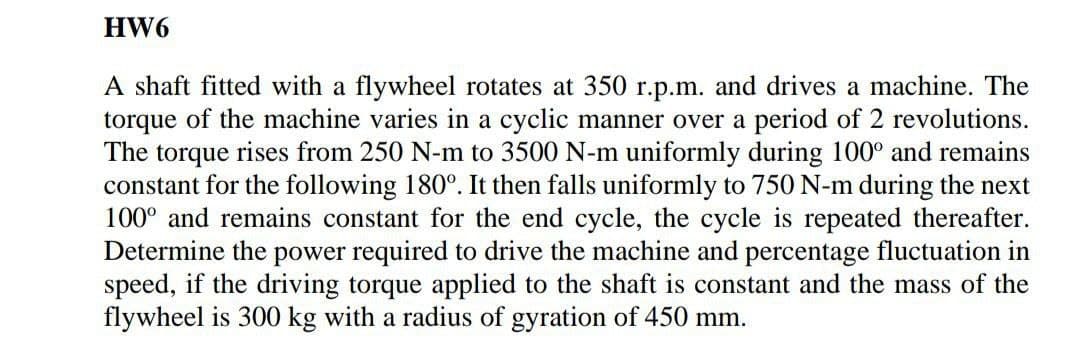A shaft fitted with a flywheel rotates at 350 r.p.m. and drives a machine. The torque of the machine varies in a cyclic manner over a period of 2 revolutions. The torque rises from 250 N-m to 3500 N-m uniformly during 100° and remains constant for the following 180°. It then falls uniformly to 750 N-m during the next 100° and remains constant for the end cycle, the cycle is repeated thereafter. Determine the power required to drive the machine and percentage fluctuation in speed, if the driving torque applied to the shaft is constant and the mass of the flywheel is 300 kg with a radius of gyration of 450 mm.
A shaft fitted with a flywheel rotates at 350 r.p.m. and drives a machine. The torque of the machine varies in a cyclic manner over a period of 2 revolutions. The torque rises from 250 N-m to 3500 N-m uniformly during 100° and remains constant for the following 180°. It then falls uniformly to 750 N-m during the next 100° and remains constant for the end cycle, the cycle is repeated thereafter. Determine the power required to drive the machine and percentage fluctuation in speed, if the driving torque applied to the shaft is constant and the mass of the flywheel is 300 kg with a radius of gyration of 450 mm.
Elements Of Electromagnetics
7th Edition
ISBN:9780190698614
Author:Sadiku, Matthew N. O.
Publisher:Sadiku, Matthew N. O.
ChapterMA: Math Assessment
Section: Chapter Questions
Problem 1.1MA
Related questions
Question

Transcribed Image Text:HW6
A shaft fitted with a flywheel rotates at 350 r.p.m. and drives a machine. The
torque of the machine varies in a cyclic manner over a period of 2 revolutions.
The torque rises from 250 N-m to 3500 N-m uniformly during 100° and remains
constant for the following 180°. It then falls uniformly to 750 N-m during the next
100° and remains constant for the end cycle, the cycle is repeated thereafter.
Determine the power required to drive the machine and percentage fluctuation in
speed, if the driving torque applied to the shaft is constant and the mass of the
flywheel is 300 kg with a radius of gyration of 450 mm.
Expert Solution
This question has been solved!
Explore an expertly crafted, step-by-step solution for a thorough understanding of key concepts.
Step by step
Solved in 3 steps with 3 images

Knowledge Booster
Learn more about
Need a deep-dive on the concept behind this application? Look no further. Learn more about this topic, mechanical-engineering and related others by exploring similar questions and additional content below.Recommended textbooks for you

Elements Of Electromagnetics
Mechanical Engineering
ISBN:
9780190698614
Author:
Sadiku, Matthew N. O.
Publisher:
Oxford University Press

Mechanics of Materials (10th Edition)
Mechanical Engineering
ISBN:
9780134319650
Author:
Russell C. Hibbeler
Publisher:
PEARSON

Thermodynamics: An Engineering Approach
Mechanical Engineering
ISBN:
9781259822674
Author:
Yunus A. Cengel Dr., Michael A. Boles
Publisher:
McGraw-Hill Education

Elements Of Electromagnetics
Mechanical Engineering
ISBN:
9780190698614
Author:
Sadiku, Matthew N. O.
Publisher:
Oxford University Press

Mechanics of Materials (10th Edition)
Mechanical Engineering
ISBN:
9780134319650
Author:
Russell C. Hibbeler
Publisher:
PEARSON

Thermodynamics: An Engineering Approach
Mechanical Engineering
ISBN:
9781259822674
Author:
Yunus A. Cengel Dr., Michael A. Boles
Publisher:
McGraw-Hill Education

Control Systems Engineering
Mechanical Engineering
ISBN:
9781118170519
Author:
Norman S. Nise
Publisher:
WILEY

Mechanics of Materials (MindTap Course List)
Mechanical Engineering
ISBN:
9781337093347
Author:
Barry J. Goodno, James M. Gere
Publisher:
Cengage Learning

Engineering Mechanics: Statics
Mechanical Engineering
ISBN:
9781118807330
Author:
James L. Meriam, L. G. Kraige, J. N. Bolton
Publisher:
WILEY